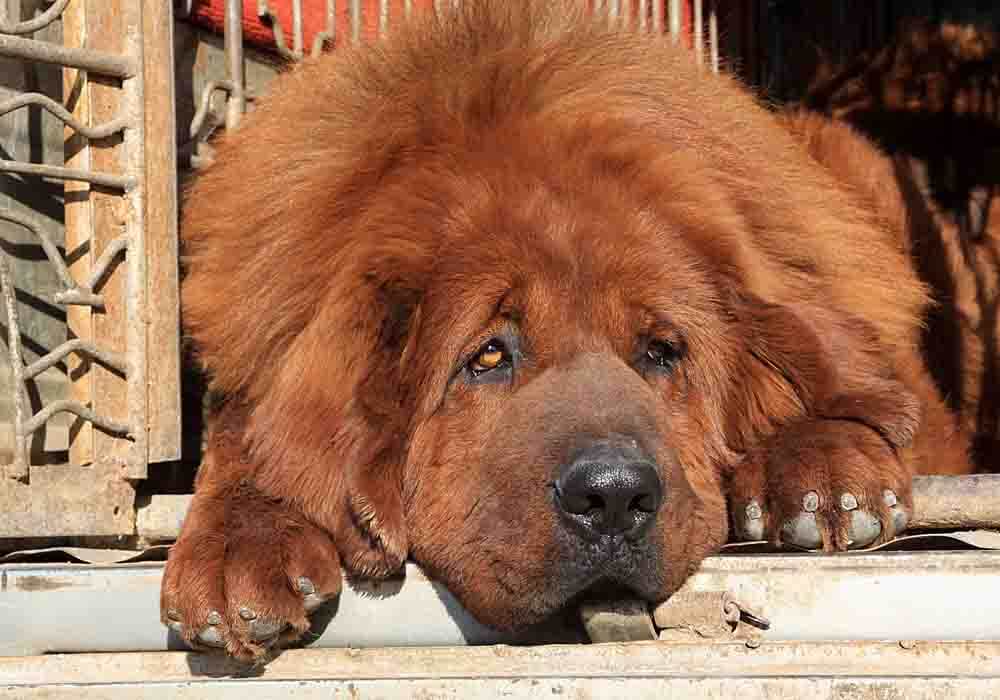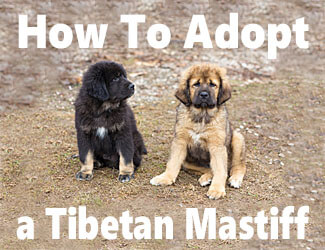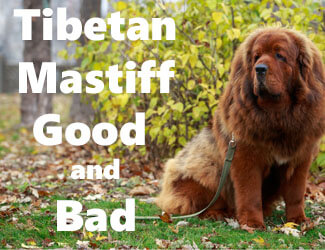Tibetan Mastiff
Temperament
and Characteristics
by Ken Alden
The Tibetan Mastiff is an ancient dog breed known for its loyalty, independence,
and intelligence. It originated in the nomadic cultures of China, India,
Mongolia, Nepal, and Tibet, but is now a popular family pet and guardian dog
for a lot of breeders.
Tibetan Mastiff Temperament And Characteristics
They're a natural protector that creates a deep bond with its owners. Puppies may be too sensitive, though, so it'll be challenging for some people to train them. They may be sweet and affectionate, but they're always suspicious and aloof with strangers—they’re always looking out for potential threats.
If you're thinking about raising one, it would be best to get in-depth with this breed. Fret not, because we'll cover this dog's complicated temperament and unique characteristics to help you decide whether having one is best for you!
Read More Below...
Pro-tip: Ever try lifting a Tibetan Mastiff? Their weight can hurt not only your back but their joints when they hop down from cars, sofas or even your bed. To protect your back and theirs check out the best Mastiff ramps on Amazon.com now.

Tibetan Mastiff Temperament
Before we cover the grandiosity and complexity of Tibetan Mastiffs, let's learn some of the basics about this breed. Here's a quick look at the things that you may want to know about these majestic giants:
Quick Facts on the Tibetan Mastiff
Other Names
Height
Affection Level
Kid-Friendly
Exercise Needs
Energy Level
Intelligence
Sheds Much?
Territorial
Dogs-Khyi (Tibetan)
Bhote Kukur (Nepali)
Zàng áo (Chinese)
Male: 26-33 in.
(66-83 cm)
Female: 24-28 in. (61-71 cm)
Medium
Medium
Medium
Medium
Medium
Above Average
High
Life span
Weight
Adaptability
Friendliness
Pet-Friendly
Playfulness
Trainability
Barks Much?
Protectiveness
10-12 years
Male: 45-73 kg
(99-161 lbs)
Female: 34-54 kg
(75-119 lbs)
Medium
Low
Medium
Medium
Medium
High
High
Pro-tip: Tibetan Mastiff anxiety, aggression, destructive chewing, jumping up, fearfulness, and other behaviors can be controlled with the right training program.
Here’s a great course that addresses these issues along with many other dog training basics: Check it out now!
Independent Yet Affectionate
Tibetan Mastiffs have one striking trait; they're independent and always secure of themselves. That's why novice breeders have a misconception with their affection towards humans. Although it'll be challenging to establish leadership over this breed, they're one of the few guard dogs that shower their family with so much affection.
Despite being fearless towards strangers,
they're highly sensitive to emotions, especially with family members. If you're
arguing with your spouse or scolding a child, this dog will always think that
he should intervene and be the intermediary, then get in the middle of an
argument between family members.
Reserved and Suspicious of Strangers
A Tibetan Mastiff won't hesitate to intervene in arguments, but when it happens between a member of "his family" and a stranger, things may turn out bad.
Even if you train this dog to behave well with strangers, they're always reserved and suspicious of other people. Since your dog doesn't have deep ties with the stranger, the initial reaction will be to take him down.
It's their instinct as a protector, but you
can minimize it with adequate socialization. If you can give your dog enough
time to understand the difference between good and bad guys, you can reduce
their tendency to attack anyone seen as a threat.
Intelligent but Challenging to Train
Tibetan Mastiffs are intelligent, perhaps smarter than most Mastiff breeds. They can understand commands easily, but after learning it, they feel like they don't have to do it unless they want to.
This breed tends to assume the role of being
the "head of the house." So, even though it's easy to raise one,
training can be challenging, requiring a lot of patience and firmness. You'll
have to establish leadership over your dog before he starts listening, so you
may have to seek professional help to train your dog effectively.
Gentle and Devoted to Family
There's no doubt that this breed is massive and intimidating, but they're gentle when interacting with family members. It's one of the best child-friendly Mastiff breeds that you can have as a family pet because they won't display their fierceness towards kids. In fact, he'll even treat it as "his" kids, looking out for their safety and welfare.
In return, you'll have to teach your kids on
how they should treat your dog. This breed may be strong-willed, but they're
highly sensitive to emotions, so making your dog feel comfortable and happy
with your child will make him a highly devoted and motivated protector.
Pro-tip: Tibetan Mastiff's (and their owners) love dog crates…and for good reasons. Crates keep dogs from mischief while you're away, are perfect for house training, for traveling by car, and provide the dog a place to de-stress. Check out the best Mastiff crates on Amazon.com now.
Tibetan Mastiff Characteristics
One reason why Tibetan Mastiffs became famous
as a guard dog is because of its striking characteristics. There's no way for
anyone to ignore this majestic, ancient behemoth, especially when walking in a
park with you. Aside from their size and appearance, here are other
characteristics that you may want to know about them:
High Energy Level
If you compare this dog's energy level with that of other Mastiff breeds, you'll think it's other-worldly. Most Mastiffs are laid-back and relaxed, often perceived as lazy, but Tibetan Mastiffs have very high energy levels. They may be calm and quiet when indoors, but they'll have a sudden shift as soon as you step outside.
In the past, people used them for hunting and
herding livestock because they have enough energy for the whole day. If you're
planning to raise one, be prepared to provide your dog with daily, heavy
exercises to keep him in his tip-top shape.
Powerful and Agile
Powerful, muscular, and extremely agile—it's how most owners describe their Tibetan Mastiff. This dog's heavy coat gives them a majestic look, but underneath is an ancient light-footed behemoth that can swiftly take down almost anything.
With a weight that can go up to 73 kg (161
lbs), you'll be in awe when you see how agile it can move around. It's one of
the reasons why people in the past use them for various work activities.
Environment Adaptive
The heavy coat is more than just an aesthetic for Tibetan Mastiffs. They use it to adapt to cold temperatures, allowing them to live outdoors even in winter. This breed originated in a freezing environment, so it's not surprising to see puppies enjoying an outdoor playtime even in winter.
One disadvantage, though, is that they can't
adapt well to hot environments. They'll survive, but you'll need to make clean,
cold water accessible for your dog throughout the summer.
Inveterate Chewers
No, not the adults—they'll most likely stay in one place when indoors. But the puppies? Oh boy! They can do more damage than most dogs. If other breeds chew on small items, Tibetan Mastiffs that haven't reached maturity can take down furniture and even your walls!
They'll reach maturity at 3 to 5 years old, so
imagine a behemoth chewing down your house! That one may be an exaggeration,
but remember, never leave this dog alone because boredom will only amplify his
tendency to chew on anything. It'd be best to bring him outside with a
companion whenever you leave the house. You'll be glad you did, and your dog
will thank you for it.
Tibetan Mastiff Temperament And Characteristics...Conclusion
Tibetan Mastiff is becoming more and more popular these days, and with good reason. This breed is one of the best guard dogs that you can have, because of its protective nature. Aside from this, here are other things you need to know about its temperament:
- Independent yet affectionate towards family members.
- Reserved and suspicious of strangers.
- Intelligent but challenging to train.
- Gentle to kids and devoted to his family.
This dog's temperament may be impressive, but its mixed characteristics might make it less ideal for some. Here are some facts that you need to know about this breed's characteristics:
- It has a high energy level that can last for a day's work.
- This dog is powerful and more agile than most Mastiffs.
- Adaptive to cold weather, but may not thrive in hot weather.
- Inveterate chewers that can do serious damages when left
unchecked.
Return to the top of this Tibetan Mastiff Temperament And Characteristics page

About the Author...
Ken Alden, a dedicated Mastiff owner for over eight years, is acclaimed for his expertise in care, grooming, and training. Read more About Me and my dog Shadow.
- Mastiff Guide Home ›
- Tibetan Mastiffs Info ›
- Tibetan Mastiff Temperament And Characteristics






